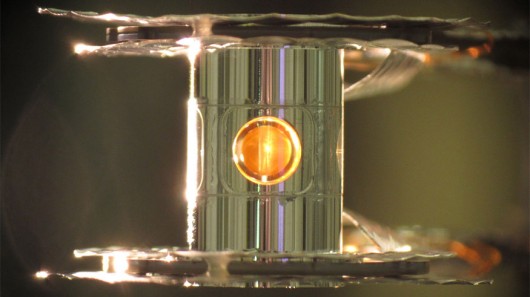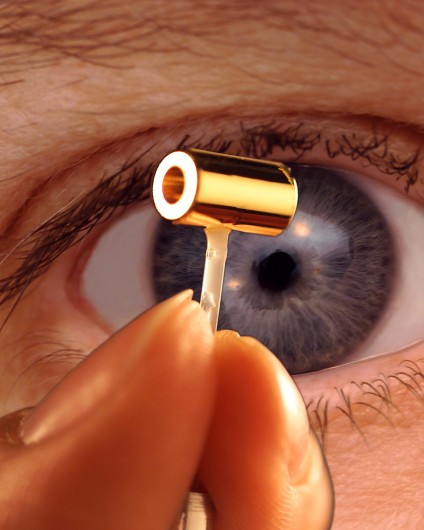Scientists announce breakthrough in quest for fusion power
By David Szondy
February 13, 2014

A metallic case called a hohlraum holds the fuel capsule for the NIF experiments (Photo: Eduard Dewald/LLNL)
In a perfect example of beating swords into plowshares, a team of scientists at the Lawrence Livermore National Laboratory's (LLNL) National Ignition Facility (NIF) in California reached a milestone in the quest for practical fusion power using a process designed for the development and testing of nuclear weapons. The announcement in the February 12 issue of Nature claims that the team used the world’s most powerful laser barrage to produce a controlled fusion reaction where more energy was extracted from the fuel than was put into it.
If there is an ultimate engineering dream, then nuclear fusion is about as close as close as one can get. By literally harnessing the power of the stars, it holds the promise of what is, for all practical purposes, unlimited clean energy. Since man-made fusion was first demonstrated in 1951 with a boosted fission weapon, scientists and engineers have worked on some way to produce a practical fusion reactor instead of a hydrogen bomb.
The story of the fusion reactor is one of both great progress, but also constant frustration. When work began, the first reactor was predicted to be 25 years away. Since then and up until today, it’s still 25 years away. That’s because although nuclear fusion is relatively simple in theory, getting a controlled reaction started outside of the heart of a star is extremely difficult. The trick is to reach the “ignition” point, where the energy released by the reactor is greater than what’s put into it and the reaction becomes self-sustaining.
A fusion reactor works by simulating the conditions inside the Sun. Put simply, hydrogen atoms fuse in the Sun because its huge mass squashes the atoms together to form helium, releasing huge amounts of energy as the strong nuclear force that keeps them apart is overcome. A hydrogen bomb does the same thing, only with a fission bomb creating the necessary conditions for a millionth of a second.
A fusion reactor creates the right pressures and temperatures by taking an ionized plasma of the hydrogen isotopes deuterium or tritium and squeezing it using magnetic fields or lasers to set off the reaction. Not surprisingly, this requires huge amounts of energy, which set off various processes that heat the plasma to incredible temperatures.
The NIF breakthrough isn’t ignition, but it is a significant waypoint. The NIF team achieved what is called a “fuel gain”. Using an array of 192 high-energy lasers aimed at one tiny plastic sphere filled with a mixture of deuterium and tritium, the scientists subjected the droplet of cryogenic fuel to 1.9 megajoules of light to produce sun-like temperatures for a tiny fraction of a second. The result was a fusion reaction where the energy put into the fuel was exceeded by the energy that came back out – something that until now has never been achieved anywhere outside of a star or a hydrogen bomb, and is ten times greater than anything previously seen. The key to this is something called "boot-strapping".
Boot-strapping works by using alpha particles, which are helium atoms stripped of their electrons. Normally, when a fusion reaction produces such particles, they shoot off, carrying energy with them. In bootstrapping, the deuterium/tritium mixture is made to capture the alpha particles, which heats the plasma more and releases more alpha particles to increase the reaction.
According to the team, the key to boot-strapping was to keep the plastic shell that contains the fuel from disintegrating during compression under a high-energy laser pulse by altering the timing of the pulse to "fluff up" the ablative plastic, making it more resilient. The team believes that this disintegration in previous tests hindered the reaction and by modifying the laser they were able to prevent this.
"What's really exciting is that we are seeing a steadily increasing contribution to the yield coming from the bootstrapping process we call alpha-particle self-heating as we push the implosion a little harder each time,” says Omar Hurricane, lead author of the team’s report.
Ironically, power generation wasn’t the team’s primary goal. The NIF is designed to provide hard data for computer models that simulate the explosion of a nuclear warhead as part of the US program to produce new warheads and to ensure that the existing stockpiles remain safe and reliable. Up until the comprehensive nuclear test ban treaty, this would have been done using underground test explosions, but the US government now relies on lasers and supercomputers for the National Nuclear Security Administration's Stockpile Stewardship Program.
Eventually, the scientists hope the boot-strapping process will lead to ignition, but that remains in the future, as does practical application in a working commercial reactor. Currently, the experiment is only able to produce of net gain of about one percent. "There is more work to do and physics problems that need to be addressed before we get to the end," said Hurricane, "but our team is working to address all the challenges, and that's what a scientific team thrives on".
The team’s results were published in the journal Nature.
Source: Lawrence Livermore National Laboratory

 David Szondy
is a freelance writer based in Monroe, Washington. An award-winning
playwright, he has contributed to Charged and iQ magazine and is the
author of the website Tales of Future Past.
David Szondy
is a freelance writer based in Monroe, Washington. An award-winning
playwright, he has contributed to Charged and iQ magazine and is the
author of the website Tales of Future Past.